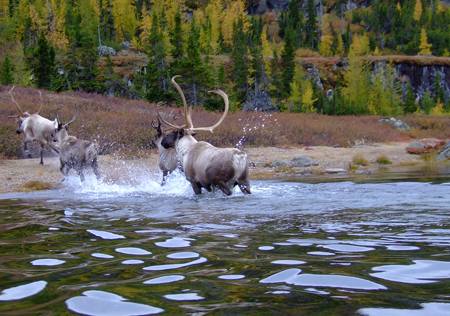
Members of the George River herd in Labrador.
Credit: Valerie Courtois, Canadian Boreal Initiative.
Woodland caribou, the nomadic and symbolic creature of Canada’s boreal forest, were once plentiful throughout mainland Canada and the northern United States. The vast stretches of forest throughout this region were perfect for the well-adapted woodland caribou, whose specialized diet allows them to eat lichens during the winter when few other plants are plentiful.
But over the past century—particularly the past few decades—a rapid expansion of industrial development and human activity have pushed this shy species northward at an alarming rate to the point where now it only occupies about half its historic range and its numbers have fallen dramatically. If these rates continue, it’s not impossible that we witness the disappearance of many woodland caribou herds within our generation.

Woodland caribou have lost around half of their historic range.
Credit: International Boreal Conservation Campaign.
To avoid such a tragedy means a dramatic shift in both thinking and policy. To that end, I recently worked with the International Boreal Conservation Science Panel and some of the world’s top caribou experts to publish Keeping woodland caribou in the boreal forest: Big challenge, immense opportunity, a science and policy briefing paper aimed at laying out the simple facts about how stop the continued decline of this magnificent animal. You can visit the webpage for this report here, which also includes letters sent to Canadian politicians calling for action: http://www.borealcanada.ca/pr/07-13-2011-e.php
Our overall recommendations for how to give woodland caribou the best chance at survival include:
- Plan at an appropriate scale for caribou that, at 10,000 to 15,000 square kilometres, often exceeds the size of conventional management units.

Only a few of Canada's protected areas are thought to be large enough to conserve woodland caribou over the long term.
Credit: International Boreal Conservation Campaign.
- Ensure that the cumulative disturbances of fire and development do not exceed risk levels, which require that at least two-thirds of caribou population range exists as natural landscapes older than 50 years.
- Avoid reliance on mitigation measures such as minimizing sensory disturbances that are inadequate to maintain caribou populations. Stated bluntly, the lack of examples of woodland caribou persistence in the midst of industrial activity implies that best-management practices are inadequate.
- Plan for uncertainty and buffer against the unexpected. Avoid venturing to the absolute limits of habitat loss, relying on untested assumptions and failing to leave room for natural disturbances.
- Consolidate disturbances; leave large intact areas. Narrow corridors in disturbed landscapes will not ensure caribou persistence. The absolute amount of suitable, available habitat is paramount and must be extensive.
- Understand and anticipate cumulative effects; forecast future scenarios and their implications for caribou.


